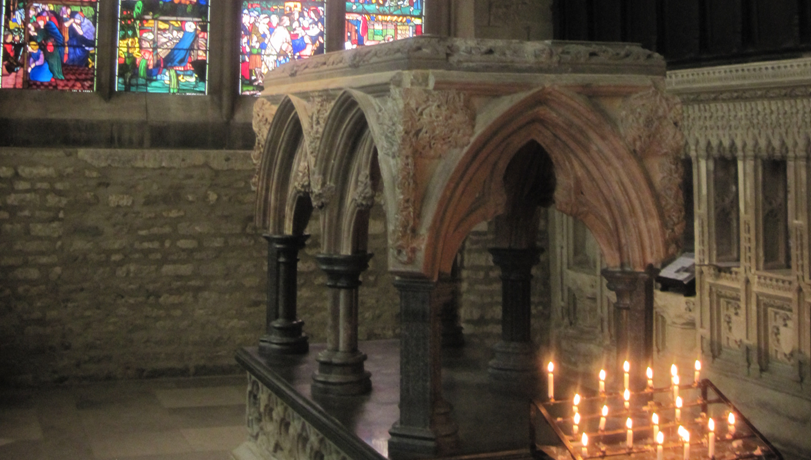 |
| Medieval stained glass in the chapel of St. Frideswide, Christ Church Cathedral. St. Frideswide is in the middle. |
Frideswide was born in the late seventh century to King Didan and Queen Selfrida, rulers of a Mercian (the Anglo-Saxon kingdom of the Midlands) sub-kingdom. At an early age, Frideswide showed interest in becoming a nun and requested that her father give money for her to establish a nunnery in Oxford, then the capital of Didan's little kingdom. She was successful in establishing and nurturing a prominent nunnery, and her reputation as a miracle worker and a holy woman in general contributed to the hallowed story that surrounds her. The legend, from a twelfth century life, is told as such: Frideswide established her community of nuns on the edge of Oxford when the King Algar of Leicester demanded that she marry him. Frideswide refused Algar's request but was sized by Algar's men, who were stuck blind upon touching her. Algar then decided to find her himself, but Frideswide was warned and escaped to the river Thames where she was transported in a boat by an Angel to Bampton, where she took cover with some of her companions in the house of a swineherd in the forest. There she stayed for several years, after establishing a community and gathering a reputation as a miracle worker. Algar was struck blind in his pursuit upon entering the city. Frideswide moved back to her Oxford nunnery from her community at Bampton where she ruled as abbess and where her fervent prayers yield still more miracles until her death in 727. Frideswide is associated with a particular well at Binsey where she hid for a time founding a chapel and working miracles and a cult grew around her simple grave. By the twelfth century, however, the monastery at Oxford had become a house of secular canons and so the Augustinians, whose special purpose, they believed was to establish centers of learning for priests hospitals for the poor and to revive shrines of saints who had fallen out of popularity. St. Frideswide's became an Augustinian monastery and in approximately 1180 after much fasting and keeping of vigils the canons were revealed her grave by miracles. The bones were translated into a shrine on 12 February 1180 and again in 1289 were they remained until the reformation when they were interred with the body of Catherine Martyr.
The Shrine of St. Frideswide at Oxford has recently been rebuilt and dominates a chapel to the north side of the high altar in Christ Church Cathedral. Frideswide is an example, as the first among the people of Oxford to give up the '"inordinate love of things of this world," for us to follow Christ by throwing away all the treasures of this world and dedicate our lives to his work. We can do this in little ways, by sacrificing small, everyday distractions so that we can focus more on Christ, what he gave to us and what we can do to spread his love. Frideswide, like many other saintly monastics, is a model for how we can do this, give up earthly distractions. Not everybody is supposed to be exactly like Frideswide, not everybody should hide themselves in the cloister, rather Frideswide's many works show us how we can do what she did on our own terms.
Heavenly Father, who inspired thy servant Frideswide to give up earthly desires for a life of prayerful dedication to the work of your son, Jesus Christ; inspire us also to cast off earthly distraction and clothe ourselves in a life in the footsteps of our savior, through the same thy Son, our Lord, who lives and reigns with you in the unity of the Holy Spirit, one God, now and for ever. Amen.
 |
| Shrine of St. Frideswide. The widow tells her legend. |



No comments:
Post a Comment